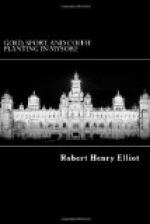I have described our life as having been one of great isolation so far as European society was concerned, but I never felt it to be a dull one, nor did my neighbours ever complain of it, though we only took a holiday of a few weeks in the year. But we had plenty of work, and big game shooting, and the occupation was an interesting one, and as I even now return with pleasure every winter to my planter’s life, this proves that my earlier days must have left behind them many pleasant associations. And the occupation and sport were really all we had to depend on. We had few books, nor any means of getting them, for I need hardly say that pioneer planters, who have to keep themselves and their coffee till the latter comes into bearing, cannot afford to buy anything that can be dispensed with. But after all this perhaps was no disadvantage, for, as a great moral philosopher has pointed out, nothing tends to weaken the resources of the mind so much as a miscellaneous course of reading unaccompanied (as it usually is, I may remark) by reflection. The management of people, the business of an estate, the exercise of the inventive powers, the cultivation of method, the sharpening of the observing and combining faculties, which are so well developed by big game shooting, yield real education, or the leading out and development of the mental resources, while books provide the individual merely with instruction which has often a tendency to cramp and even to fossilize the mind.
I have said at the outset, that the journey to India is not the same as it was in 1855, and that still less is India the same India, and I may certainly say that still less is Western Mysore the Western Mysore of 1855, except that its beautiful scenery is as beautiful as ever. For our planting is not like that of Ceylon, where the planter, like the locust, finds a paradise in front to leave a desert in his rear—a desert of bare lull sides from which the beautiful forest has been entirely swept away, while the most valuable constituents of the soil have been washed down to the river beds. And when standing in 1893 on a lull in my district of Manjarabad, and looking around, I can see no sign of change in the landscape from the days of 1855, except that the woodland paths leading from village to village are much more distinctly marked, owing to the great increase of labourers employed in the numerous native and European plantations, which now stretch in an unbroken line along all the western border of Mysore. And no sign of change is apparent, because all the coffee is planted either under the shade of the original forest trees, or under the shade of trees which have been planted to take their place. But all else is practically and largely changed by the agency of a universal progress, which has been brought about by British government and the introduction of British capital, skill, and energy. And this progress, I am glad to be able to say, has benefited all classes of the community, and the labouring classes




